Abstract
Crash boxes play a crucial role in mitigating force during vehicle collisions by absorbing impact energy. Additive manufacturing (AM), particularly Fused Deposition Modeling (FDM), has emerged as a promising method for their fabrication due to its design flexibility and continuous advancements in material development. This study investigates the crash performance of tapered crash box configurations, each manufactured using two FDM materials: Carbon Fiber-Reinforced Polylactic Acid (PLA-CF) and Polylactic Acid Plus (PLA+). The specimens vary in wall thickness and taper angles to evaluate the influence of geometric and material parameters on crashworthiness. The results demonstrated that both specific energy absorption () and crush force efficiency () increase with wall thickness and taper angle, with PLA-CF consistently outperforming PLA+ in both metrics. ANOVA results showed that wall thickness is the most influential factor in crashworthiness, accounting for 73.18% of variation and 58.19% of variation. Taper angle contributed 13.49% to and 31.49% to , while material type had smaller but significant effects, contributing 0.66% to and 0.11% to . Regression models were developed based on the experimental data to predict and with a maximum absolute percentage error of 4.97%. These models guided the design of new configurations, with the optimal case achieving an of 32.086 ± 0.190 kJ/kg and a of 0.745 ± 0.034. The findings confirm the potential of PLA-CF in enhancing the energy-absorption capability of crash boxes, particularly in tapered designs.
1. Introduction
Crash boxes are critical components designed to absorb impact energy during vehicle collisions, reducing the force transmitted to the main structure and enhancing occupant safety. They are specifically engineered to deform upon impact, effectively dissipating energy. Crashworthiness refers to a crash box’s ability to absorb impact energy and protect occupants during a collision [1]. Traditionally, crash boxes have been manufactured using processes such as composite fabrication [2], wire electrical discharge machining [3], extrusion [4,5], welding [6,7], CNC water jet cutting [8], and stamping [9,10]. Crash boxes fabricated using these methods often involve complex, multi-step production processes and offer limited geometric flexibility. In recent years, additive manufacturing (AM), originally introduced by Charles Hull in 1984 [11], has significantly expanded design possibilities by enabling the fabrication of intricate geometries previously unattainable with conventional techniques. This advancement is particularly important for crash box development, where geometry plays a central role in energy-absorption performance.
A variety of additive manufacturing (AM) techniques are available, each offering distinct advantages and limitations. The selection of an appropriate AM method depends on several factors, including material compatibility, processing speed, resolution, and cost-effectiveness. AM technologies such as Stereolithography (SLA) [12,13], Material Jetting (MJT) [14,15], Selective Laser Melting (SLM) [16,17], Selective Laser Sintering (SLS) [18,19], and Fused Deposition Modeling (FDM) [20,21,22] have been successfully employed in the fabrication of crash boxes, demonstrating their capability to produce complex geometries with tailored energy-absorption characteristics. Among various AM techniques, FDM has gained widespread adoption due to its accessibility, versatility, and advancements in both technology and material development, making it increasingly efficient, cost-effective, and suitable for crash box production [23]. Additionally, FDM enables the fabrication of fiber-reinforced polymer structures that offer an optimal balance of lightweight properties, structural integrity, and design flexibility, making them well-suited for lightweight energy-absorbing applications.
Several studies have compared different materials used in FDM to assess their impact on energy-absorbing performance [24,25,26]. For example, Zhang et al. [27] investigated metamaterial lattice structures fabricated with Polylactic Acid (PLA) and Polyethylene Terephthalate Glycol (PETG). Their study examined unit-cell configurations, including hexagonal, hybrid, and re-entrant layouts, with PETG re-entrant honeycomb demonstrating the highest performance. Similarly, Isaac et al. [28] investigated the performance of five polymer-based honeycomb lattice structures fabricated from four different materials: PLA, PETG, ABS (Acrylonitrile Butadiene Styrene), ASA (Acrylonitrile Styrene Acrylate), and PA-CF (Polyamide–Carbon Fiber), highlighting PETG’s superior energy-absorption performance. Furthermore, Wang et al. [29] explored the energy-absorption properties of thin-walled tubular structures made from PA (Polyamide), PA-CF, and PA-GF (Polyamide–Glass Fiber). They concluded that PA-CF exhibited the highest energy-absorption performance.
In addition to material considerations, the geometric configurations enabled by FDM technology have been extensively investigated to enhance energy-absorption performance [30,31,32]. Wang et al. [33] examined multi-cell-filled tubes with internal cell geometries, including circular, hexagonal, and triangular shapes, all fabricated from PA-CF. They concluded that circular-filled configurations demonstrated superior energy absorption to both hexagonal and triangular designs. Liu et al. [34] explored stepwise graded multi-cell tubes (SGMTs) and continuous graded multi-cell tubes (CGMTs), produced using PA-CF. Their findings showed that CGMTs offered improved energy absorption due to the absence of discontinuous interfaces, which contributed to more uniform deformation. Liu et al. [35] investigated assembled and integrated lattice-filled multi-cell tubes made from PA-CF. Their integrated designs exhibited enhanced performance, benefiting from a synergistic effect between the lattice and tube structures, resulting in greater energy absorption than the sum of their individual components.
The continuous advancement of Fused Deposition Modeling (FDM) materials, particularly Carbon Fiber-Reinforced Polylactic Acid (PLA-CF) and Polylactic Acid Plus (PLA+), has opened new avenues for fabricating crash boxes with enhanced energy-absorption capabilities. These materials were selected based on their commercial availability, compatibility with standard FDM printers, and suitability for lightweight structural applications without requiring specialized processing. PLA-CF offers improved stiffness and strength due to its carbon fiber reinforcement, while PLA+ delivers enhanced ductility and toughness through its modified formulation. Although PLA-CF demonstrates higher stiffness, crashworthiness is influenced by a combination of material and geometric characteristics, including ductility, deformation behavior, and energy dissipation mechanisms. Therefore, both materials present distinct advantages for energy-absorbing structures. However, a systematic comparison between these two materials has not yet been explored. In this study, the crash performance of nine distinct tapered-tube crash box designs was investigated, with each design printed once using PLA+ and once using PLA-CF, resulting in a total of 18 specimens. The specimens featured varying wall thicknesses and tapered angles to comprehensively assess their effects on crash performance. Upon completing the testing of 18 specimens, the best candidates were further investigated by varying the thickness and the taper angle. The additional three experiments concluded the investigation. This study highlights how material and geometric parameters together affect crashworthiness, aiding the design of more effective FDM-manufactured crash boxes. The results of this study can serve as benchmark results for finite element analysis comparison.
2. Experimental Procedure
2.1. Geometrical Design
A tapered-tube geometry was adopted in this study to evaluate and compare the crashworthiness performance of different FDM materials, as tapered configurations have demonstrated superior energy-absorption characteristics to straight tubes [36]. All the specimens maintained a constant height (H) of 60 mm and an outer base diameter (D) of 30 mm, where T denotes the wall thickness and A represents the taper angle. To systematically investigate the influence of geometrical parameters, three wall thicknesses (1.0 mm, 1.5 mm, and 2.0 mm) and three taper angles (0°, 2.5°, and 5.0°) were selected. This full factorial design resulted in nine distinct geometric configurations. Each configuration was fabricated once using PLA+ and once using PLA-CF, yielding a total of 18 specimens for crash testing. A 50 mm × 50 mm × 2 mm base plate was integrated into the bottom of each specimen to ensure stability during compression testing. The geometry and dimensional specifications of the specimens are illustrated in Figure 1, while the specific configurations of wall thickness and taper angle used in the study are summarized in Table 1.

Figure 1.
Geometry and dimensional specifications of the specimens.

Table 1.
Design configurations based on T and A.
2.2. Materials and Processing Parameters
In this study, all the specimens were fabricated using a 1.75 mm filament provided by Shenzhen eSUN Industrial Co., Ltd., Shenzhen, China, with the corresponding mechanical properties summarized in Table 2. The geometrical models were created using SOLIDWORKS and exported in STL (Standard Tessellation Language) format. These STL files were processed in PrusaSlicer to generate G-code instructions for the Prusa XL FDM 3D printer, both developed and manufactured by Prusa Research, based in Prague, Czech Republic. FDM-fabricated components exhibit anisotropic mechanical properties due to differences in inter-layer adhesion. To ensure consistency and isolate the influence of geometry and material, all specimens were printed in a vertical orientation (Z-axis), with layers parallel to the base plate. This orientation was selected, as it offers enhanced structural performance under axial loading and is commonly adopted in studies evaluating crash performance [37]. The printing parameters were selected following the recommendations of both the filament and printer manufacturers. The applied printing parameters are detailed in Table 3.

Table 2.
Mechanical properties of PLA+ and PLA-CF.

Table 3.
Printing parameters of PLA+ and PLA-CF.
Figure 2a displays the final printed specimens, each labeled on its integrated base for identification. These alphanumeric labels denote specific geometrical and material attributes; for instance, “T2A0C” corresponds to a 2 mm wall thickness, 0° taper angle, and PLA-CF material, while “T1A2.5+” represents a 1 mm wall thickness, 2.5° taper angle, and PLA+ material. For each PLA+ and PLA-CF specimen, a separate base (50 mm × 50 mm × 2 mm) was 3D printed, as illustrated in Figure 2b.

Figure 2.
Three-dimensional printed (a) PLA+ and PLA-CF specimens; (b) PLA+ and PLA-CF bases.
2.3. Experimental Method
Quasi-static axial compression tests were conducted at room temperature to assess the crashworthiness of the fabricated specimens. A Tinius Olsen universal testing machine (Model 50ST), manufactured by Tinius Olsen (Horsham, PA, USA) and equipped with a 50 kN load cell, was used for testing, as shown in Figure 3. Prior to testing, the specimen’s total mass, including the base, was measured, and the mass of the base was subtracted to determine the mass of the specimen alone. The specimens were placed between the two flat plates of the testing machine. The lower plate incorporated a 3D-printed frame with a groove (50 mm × 50 mm × 2 mm) that securely held the specimen base in position, ensuring proper alignment and preventing slippage during compression, as shown in Figure 3. The upper plate moved downward at a speed of 5 mm/min [38,39], applying a compressive force on the specimens, with the crushing displacement set to 2/3 of the specimen’s original height [33,40]. Force-displacement data were continuously recorded during the compression tests.
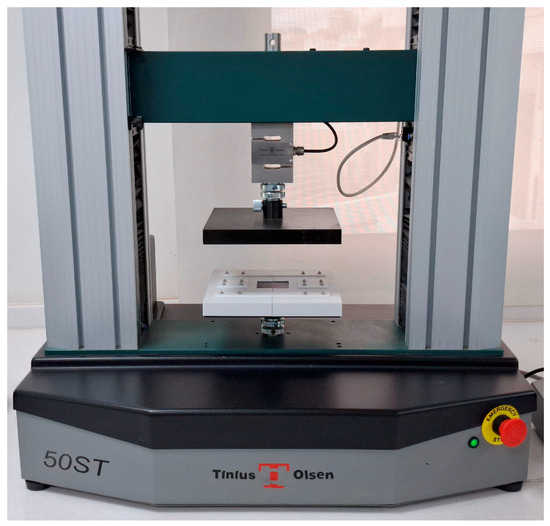
Figure 3.
Tinius Olsen universal testing machine used in the testing of specimens.
2.4. Definition of Crashworthiness Indicators
Crash box performance is typically evaluated through key metrics that indicate its ability to absorb impact forces. These metrics are derived from the force-displacement curve. The primary parameters used for this evaluation are summarized below [41]:
2.4.1. Total Energy Absorption,
The total energy absorption of a crash box can be determined by calculating the work achieved by the crushing force. It is represented by the area under the axial force versus the axial displacement curve. is expressed as follows:
where is the crushing force, is the displacement, and is the total crush displacement.
2.4.2. Peak Crush Force,
The peak crush force is the maximum force observed in the axial direction during the crushing process.
2.4.3. Mean Crush Force,
The mean crush force is defined as the total energy absorbed per unit of total crush displacement. It is expressed as follows:
2.4.4. Specific Energy Absorption,
Specific energy absorption is defined as the total energy absorbed per unit mass of the crash box. It is expressed as follows:
where is the mass of the crash box. A higher indicates greater energy absorption per unit mass, which helps reduce the kinetic energy transmitted to occupants and thereby enhances safety.
2.4.5. Crush Force Efficiency,
Crush force efficiency is defined as the ratio of the to the . It is expressed as follows:
A higher reflects a lower , resulting in less force being transferred to the passenger.
3. Results and Discussion
3.1. Post-Compression Behavior of the Tested Specimens
The post-compression condition of the tested specimens is presented Figure 4. Most configurations demonstrated a favorable progressive folding pattern, characterized by the sequential and uniform formation of folds, indicating stable deformation and efficient energy absorption. The PLA-CF specimens generally exhibited more localized fractures than the PLA+ specimens, suggesting that the inclusion of carbon fibers in PLA-CF may contribute to a more brittle failure response under compressive loading. Specimen T1A0C, however, deviated from this behavior, experiencing brittle fracture instead of folding, which significantly reduced energy absorption. This failure is attributed to its basic cylindrical geometry with a 0° taper angle, a reduced wall thickness of 1 mm, and the inherently brittle nature of PLA-CF. These results indicate that increasing the wall thickness and taper angle may help reduce the occurrence of brittle fracture.
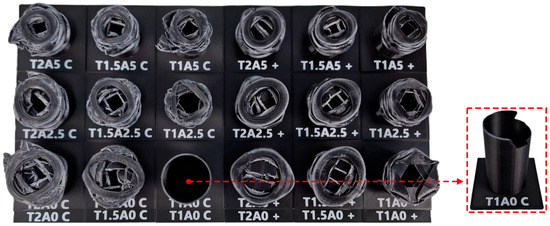
Figure 4.
Condition of specimens after compression testing.
3.2. Force-Displacement Curves
The force-displacement curves for the different design configurations are presented in Figure 5. The curves reveal varied behaviors under axial compression, with the majority of configurations showing consistent and uniform plastic deformation, except for T1A0C, which displayed brittle fracture. The was observed within the displacement range of 1–5 mm for all configurations. The highest was recorded for T2A0+ and T2A0C, at 11.963 kN and 12.155 kN, respectively. In contrast, the lowest values were observed in T1A5+ and T1A5C, with forces of 3.934 kN and 4.084 kN. After reaching their peak, all the specimens transitioned into a more stable force region, where the load fluctuated around a mean crush force, indicating continuous energy absorption.
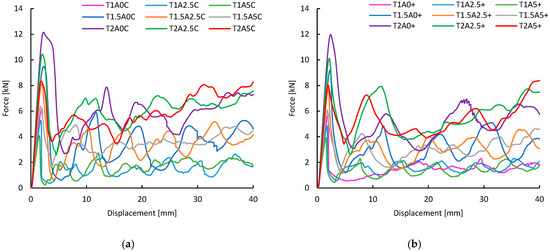
Figure 5.
Force-displacement curves of different design configurations: (a) PLA-CF; (b) PLA+.
3.3. Crashworthiness Indicators
The crashworthiness indicators , , , , and for the various design configurations fabricated from PLA-CF and PLA+ are presented in Table 4, including the mass of each specimen. Column charts are utilized to visually present the mass and the crashworthiness indicators, as illustrated in Figure 6. The mass of the specimens clearly depends on both the geometric configuration and the material type. Specifically, the mass increases with wall thickness and decreases with larger taper angles. PLA-CF consistently displays values comparable to or slightly lower than PLA+, which is attributable to its slightly lower density (1.21 g/cm3) relative to that of PLA+ (1.23 g/cm3). The highest mass, recorded in T2A0C and T2A0+, is 12.2 g, while the lowest, observed in T1A5C, is 5.1 g.

Table 4.
Crashworthiness indicators for various design configurations fabricated from PLA-CF and PLA+.
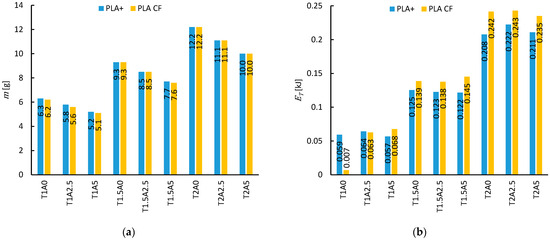
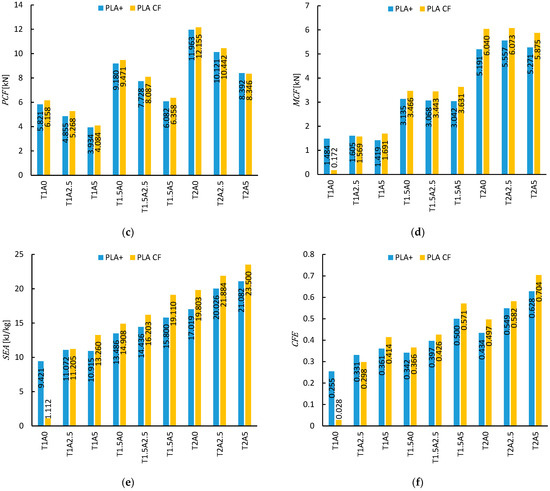
Figure 6.
The mass of each specimen (a) and the crashworthiness indicators: (b) ; (c) ; (d) ; (e) ; (f) .
For , values rise with increased wall thickness and show minimal sensitivity to taper angle variations. PLA-CF generally outperforms PLA+ in , except in configuration T1A0C, where brittle fracture limited the value to 0.01 kJ. The maximum is achieved in T2A2.5C at 0.243 kJ.
is influenced by both geometric parameters, increasing with thickness and decreasing with greater taper angle, a well-established behavior in tapered structures. PLA-CF generally yields a slightly higher than PLA+. The highest value is observed in T2A0C at 12.155 kN and the lowest in T1A5+ at 3.934 kN.
follows a trend comparable to , with values rising as thickness increases and showing limited dependence on the taper angle. PLA-CF typically produces a higher than PLA+, aside from T1A0C, which experienced brittle failure, reducing the to 0.172 kN. The peak value, 6.073 kN, is attained at T2A2.5C.
is responsive to both geometric parameters, increasing with thickness and taper angle. Although remains largely unchanged with the taper angle, the concurrent reduction in mass results in an elevated , as it is dependent on both. A higher indicates enhanced energy absorption per unit mass, contributing to reduced kinetic energy transfer to occupants. PLA-CF generally exhibits superior performance to that of PLA+. T2A5C achieves the highest at 23.5 kJ/kg, whereas T1A0C, due to brittle failure, shows the lowest value, at 1.112 kJ/kg.
similarly increases with both thickness and taper angle. While remains relatively stable with changing taper angle, the associated decline in improves , as it is defined by the -to- ratio. A higher reflects better load stability during deformation, minimizing the force transferred to occupants. PLA-CF configurations consistently yield higher values than PLA+, with the most favorable outcome observed in T2A5C at 0.704. Conversely, the lowest value of 0.028 occurs in T1A0C due to brittle failure.
4. Taguchi Analysis of Crashworthiness Indicators
In this study, Taguchi analysis was conducted using Minitab statistical software (version 19) to investigate the influence of design parameters on crashworthiness performance. The main effects plots for means provide a clear visualization of how each factor level affects the response variables. These plots, shown in Figure 7, highlight the trends in and across different parameter levels. These trends suggest that the use of PLA-CF over PLA+ and increasing both thickness and taper angle can improve both SEA and CFE.
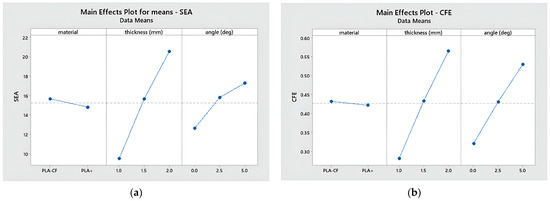
Figure 7.
Main effects plots for means: (a) ; (b) .
The response tables for means corresponding to SEA and CFE are presented in Table 5. It is observed that the most influential factor is the tube thickness for both SEA and CFE, whereas the least influential factor is the tube material. The taper angle is the second most influential factor, and its effect is more pronounced on CFE than on SEA.

Table 5.
Response table for the means of SEA and CFE.
5. ANOVA of Crashworthiness Indicators
A statistical analysis of variance (ANOVA) was performed using Minitab statistical software (version 19) to quantitatively assess the effects of the geometric and material parameters on crash performance. The factors included the continuous variables (thickness and taper angle) as well as the categorical variable (material type). The ANOVA results are listed in Table 6 and Table 7. Thickness is the most influential factor, accounting for 73.18% of the variation in and 58.19% in , confirming that increasing wall thickness substantially improves crash performance. Taper angle contributes 13.49% of the variation in and 31.49% in , highlighting the importance of geometric design in crashworthiness optimization. Material type accounts for smaller contributions of 0.66% in and 0.11% in . The residual error accounts for 12.67% and 10.22% of the variation in and , respectively. For both SEA and CFE, the p-values corresponding to thickness and angle indicate that the ANOVA results related to these parameters are statistically significant, whereas the p-values corresponding to material show that the ANOVA results related to material are statistically insignificant.

Table 6.
ANOVA results for .

Table 7.
ANOVA results for .
6. Regression Analysis
The experiment involved varying three parameters: thickness, taper angle, and filament material. These parameters were used to develop regression models for predicting output responses, specifically for and . To model these responses, a second-order polynomial response surface (PRS) approach was used. The general form of the second-order polynomial model is expressed as follows [42]:
where represents an approximation of the actual response function ( or ), consists of variables (thickness and taper angle ), and the coefficients , , , and are the regression coefficients determined using the least-squares technique. For each filament material, two separate regression models were developed, one for and one for . MATLAB (version R2013b) functions polyfitn and polyvaln were utilized for the polynomial fitting and evaluation of the model predictions, respectively. Specimen T1A0C was excluded from the training points due to early specimen failure, potentially leading to incorrect model predictions. The regression models for PLA-CF and PLA+ are presented below:
To evaluate the accuracy of the generated models, two numerical estimators, namely R-squared and Maximum Absolute Percentage Error , were employed to validate the models, as outlined in Equations (10) and (11) [36]. The resulting values are provided in Table 8.
where is the total number of data points, is the actual value, is the predicted value, and is the mean of the actual values.

Table 8.
Error assessment of the regression models for PLA-CF and PLA+.
The 3D contour plots of the and models for both PLA-CF and PLA+ are illustrated in Figure 8, providing a detailed visualization of their predictive performance. In all the plots, the regression models accurately interpolate the training data. It is observed that both and increase with greater thickness and taper angle, with PLA-CF consistently outperforming PLA+. Higher and values indicate enhanced crashworthiness by improving energy absorption and reducing the force transmitted to occupants. These trends suggest that increasing both thickness and taper angle can lead to improved crash performance. Based on this observation, three additional design cases were proposed, as shown in Figure 9a: T2A7.5C, T2.5A7.5C, and T3A7.5C.
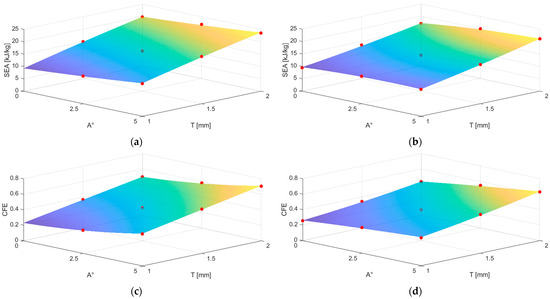
Figure 8.
Regression-based response surfaces, with training points indicated by red dots: (a) PLA-CF; (b) PLA+; (c) PLA-CF; (d) PLA+.
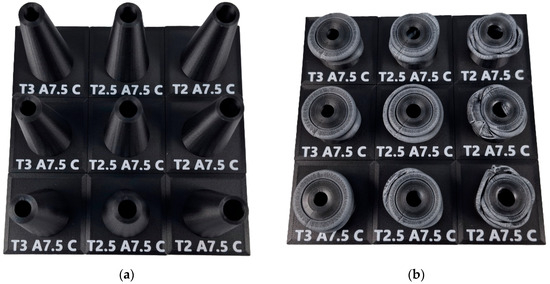
Figure 9.
Proposed design configurations: (a) before compression; (b) after compression.
The condition of the T2A7.5C, T2.5A7.5C, and T3A7.5C specimens after the compression tests is shown in Figure 9b. Each configuration was tested three times, and the mean values, along with the corresponding standard deviations of the crashworthiness indicators and specimen mass, are presented in Table 9. In addition, the corresponding force-displacement curves for all three replicates of each configuration are illustrated in Figure 10. Among the configurations, T3A7.5C consistently demonstrated the highest performance, achieving an average of 32.086 ± 0.190 kJ/kg and an average of 0.745 ± 0.034. These results confirm the superior crashworthiness of the T3A7.5C design and validate the positive influence of increased thickness on both and . The low standard deviations reported indicate good repeatability of the experimental results, supporting the reliability of the regression model-guided design strategy.

Table 9.
The mean and standard deviations obtained through three test replicates for the proposed design configurations.
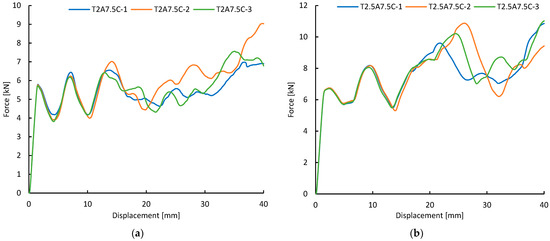
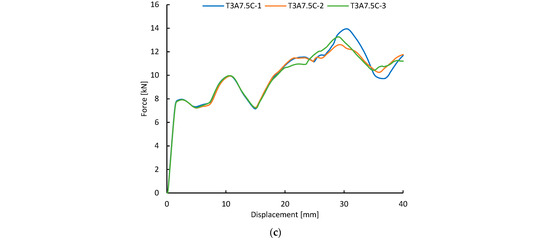
Figure 10.
Force-displacement of the three test replicates for each proposed design configuration: (a) T2A7.5C; (b) T2.5A7.5C; (c) T3A7.5C.
A comparative evaluation was conducted between the optimal crash box developed in the present study and the optimal design configurations reported in the recent literature concerning FDM-fabricated tubular crash boxes, as depicted in Figure 11. The figure illustrates the correlation between and for structures manufactured using various materials, including PLA, PLA+, PLA-LW, PA-CF, and TPU. Among the compared designs, the T3A7.5C specimen exhibits the highest while maintaining a substantial relative to the crash boxes reported in previous studies. These findings highlight the strong potential of PLA-CF, particularly in tapered geometries, for high-performance crash box applications.
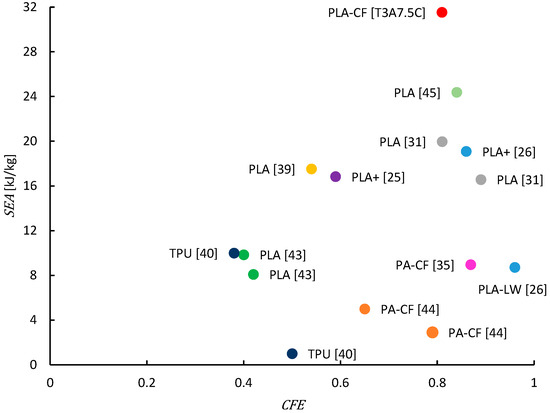
Figure 11.
Comparison of and values for tubular crash boxes manufactured using the FDM process in recent studies [25,26,31,35,39,40,43,44,45].
7. Limitations and Practical Implications
Despite the promising energy-absorption characteristics demonstrated by the tapered FDM-printed PLA+ and PLA-CF structures, several limitations restrict their direct application in high-performance or safety-critical automotive environments. PLA-based materials, including PLA-CF, exhibit inherent drawbacks such as relatively low thermal stability, limited impact resistance at elevated temperatures, and susceptibility to moisture absorption. These factors compromise their long-term durability and reliability under real-world operating conditions.
Nevertheless, PLA+ and PLA-CF remain valuable for rapid prototyping and early-stage design validation. Their low cost and ease of fabrication make them suitable for iterative development cycles, the functional testing of geometric concepts, and applications in lightweight, low-speed vehicles, robotics, and other products where crash energy demands are less strict.
Future research should focus on translating the optimized geometries identified in this study to higher-performance additive manufacturing materials, including nylon, carbon fiber-reinforced nylon, or metal-based AM processes. Such approaches have the potential to enhance thermal resistance, mechanical performance, and overall structural integration, thereby improving their feasibility for real-world operational conditions.
8. Conclusions
In this study, the crashworthiness performance of 3D-printed tapered-tube crash boxes was investigated. The specimens were fabricated using Fused Deposition Modeling (FDM) with two advanced filament materials: PLA-CF and PLA+. A series of nine geometric configurations were designed by varying wall thicknesses and taper angles, and each configuration was printed using both materials to comprehensively evaluate their structural response under quasi-static axial compression. The results demonstrate that greater wall thickness and larger taper angles significantly improve energy-absorption characteristics. Across all configurations, PLA-CF consistently outperformed PLA+ in both and , indicating its suitability for energy-dissipating applications. ANOVA confirmed that thickness, taper angle, and material type significantly affect and . Thickness was the most influential factor, accounting for 73.18% of the variation in and 58.19% in , followed by taper angle, with contributions of 13.49% and 31.49%, respectively. Material type had smaller but meaningful impacts, contributing 0.66% to and 0.11% to . Based on the experimental dataset, second-order polynomial regression models were developed to predict and , yielding a maximum absolute percentage error of 4.97%. These models were further utilized to guide the design of new configurations. The optimal design, defined by a thickness of 3 mm and a taper angle of 7.5 degrees using PLA-CF, achieved an of 32.086 ± 0.190 kJ/kg and a of 0.745 ± 0.034. The findings highlight the effectiveness of tapered-tube designs and the use of PLA-CF material in improving crashworthiness performance.
Author Contributions
Conceptualization, A.S. and M.A.G.; methodology, A.S., E.A. and M.A.G.; formal analysis, O.S.E., A.S., E.A. and M.A.G.; investigation, O.S.E., A.S., E.A. and M.A.G.; resources, A.S. and M.A.G.; data curation, H.A., A.S. and M.A.G.; writing—original draft preparation, O.S.E., H.A., A.A. and Y.A.; writing—review and editing, A.S., E.A. and M.A.G.; visualization, A.S., E.A. and M.A.G.; supervision, A.S. and M.A.G.; project administration, M.A.G. All authors have read and agreed to the published version of the manuscript.
Funding
This research received no external funding.
Data Availability Statement
The data presented in this study are available on request from the corresponding author.
Conflicts of Interest
The authors declare no conflicts of interest.
References
- Omar, M.A. The Automotive Body Manufacturing Systems and Processes; John Wiley and Sons: Hoboken, NJ, USA, 2011; ISBN 9780470976333. [Google Scholar]
- Bandinelli, F.; Ciampaglia, A.; Ciardiello, R.; Peroni, L.; Peroni, M.; Scapin, M. High Strain Rate Testing of Carbon-Epoxy Laminate Crash Boxes Filled with Polymeric Cellular 3D-Printed Cores. Int. J. Impact Eng. 2025, 205, 105401. [Google Scholar] [CrossRef]
- Chen, J.; Li, E.; Liu, W.; Mao, Y.; Hou, S. Crashworthiness Analysis of Novel Cactus-Inspired Multi-Cell Structures under Axial Crushing. Int. J. Mech. Sci. 2024, 268, 109053. [Google Scholar] [CrossRef]
- Hanssen, A.G.; Langseth, M.; Hopperstad, O.S. Static and Dynamic Crushing of Circular Aluminum Extrusions with Aluminum Foam Filler. Int. J. Impact Eng. 2000, 24, 475–507. [Google Scholar] [CrossRef]
- Hanssen, A.G.; Langseth, M.; Hopperstad, O.S. Static and Dynamic Crushing of Square Aluminum Extrusions with Aluminum Foam Filler. Int. J. Impact Eng. 2000, 24, 347–383. [Google Scholar] [CrossRef]
- Wesselmecking, S.; Kreins, M.; Dahmen, M.; Bleck, W. Material Oriented Crash-Box Design—Combining Structural and Material Design to Improve Specific Energy Absorption. Mater. Des. 2022, 213, 110357. [Google Scholar] [CrossRef]
- Kaczyński, P.; Makuła, P. Constitutive Strength Model for Spot Joints of Thin-Walled Energy-Absorbing Elements. Eng. Struct. 2023, 292, 116592. [Google Scholar] [CrossRef]
- Aktaş, C.; Acar, E.; Güler, M.A.; Altın, M. An Investigation of the Crashworthiness Performance and Optimization of Tetra-Chiral and Reentrant Crash Boxes. Mech. Based Des. Struct. Mach. 2023, 51, 6881–6904. [Google Scholar] [CrossRef]
- Ma, J.; Dai, H.; Shi, M.; Yuan, L.; Chen, Y.; You, Z. Quasi-Static Axial Crushing of Hexagonal Origami Crash Boxes as Energy Absorption Devices. Mech. Sci. 2019, 10, 133–143. [Google Scholar] [CrossRef]
- Yuan, L.; Shi, H.; Ma, J.; You, Z. Quasi-Static Impact of Origami Crash Boxes with Various Profiles. Thin-Walled Struct. 2019, 141, 435–446. [Google Scholar] [CrossRef]
- Hull, C.W.; Arcadia, C. Apparatus for Production of Three Dimensional Objects by Stereolithography. US4575330A, 11 March 1986. [Google Scholar]
- Li, Q.; Wang, W.; Tan, H.; Long, X.; Wang, F.; Hu, L. Energy Absorption Characteristics of Modular Assembly Structures under Quasi-Static Compression Load. Compos. Struct. 2024, 342, 118260. [Google Scholar] [CrossRef]
- Wang, Y.J.; Zhang, Z.J.; Xue, X.W.; Zhou, J.; Song, Z.X. Axial and Lateral Crushing Performance of Plate-Lattice Filled Square Sandwich Tubes. Compos. Struct. 2021, 274, 114404. [Google Scholar] [CrossRef]
- Tao, Y.; Li, W.; Wei, K.; Duan, S.; Wen, W.; Chen, L.; Pei, Y.; Fang, D. Mechanical Properties and Energy Absorption of 3D Printed Square Hierarchical Honeycombs under In-Plane Axial Compression. Compos. Part B Eng. 2019, 176, 107219. [Google Scholar] [CrossRef]
- Zhang, X.; Xie, J.; Chen, J.; Okabe, Y.; Pan, L.; Xu, M. The Beetle Elytron Plate: A Lightweight, High-Strength and Buffering Functional-Structural Bionic Material. Sci. Rep. 2017, 7, 4440. [Google Scholar] [CrossRef]
- Xu, W.; Wang, C.; Liu, B.; Jia, S. Crushing Responses and Energy Absorption of Bionic Inspired Corrugated Honeycombs. Int. J. Impact Eng. 2023, 179, 104641. [Google Scholar] [CrossRef]
- Yang, K.; Li, Z.; Ge, D. Quasi-Static and Dynamic out-of-Plane Crashworthiness of 3D Curved-Walled Mixed-Phase Honeycombs. Thin-Walled Struct. 2023, 182, 110305. [Google Scholar] [CrossRef]
- Tang, Y.; Li, Q.; Miao, X.; Chen, B.; Yin, L.; Liu, X.; Gu, C. Design Novel Origami Structures for Energy Absorption under Compressive Load. Acta Mech. Sin. Xuebao 2024, 40, 423271. [Google Scholar] [CrossRef]
- Zeng, Y.; Du, X.; Yao, H.; Li, P.; Dong, P.; Chen, J. An Nylon Lattice Structure with Improved Mechanical Property and Energy Absorption Capability. Compos. Part C Open Access 2022, 8, 100285. [Google Scholar] [CrossRef]
- Peng, X.; Liu, G.; Li, J.; Wu, H.; Jia, W.; Jiang, S. Compression Property and Energy Absorption Capacity of 4D-Printed Deformable Honeycomb Structure. Compos. Struct. 2023, 325, 117591. [Google Scholar] [CrossRef]
- Raj, R.; Jiyalal Prajapati, M.; Tsai, J.T.; Kumar, A.; Jeng, J.Y. Design and Additive Manufacturing of Novel Hybrid Lattice Metamaterial for Enhanced Energy Absorption and Structural Stability. Mater. Des. 2024, 245, 113268. [Google Scholar] [CrossRef]
- Shen, W.; Zhang, Z.; Okudan Kremer, G.E.; Qin, H. Origami-Inspired Infill Pattern for Additive Manufacturing. Manuf. Lett. 2022, 33, 516–520. [Google Scholar] [CrossRef]
- Capasso, I.; Andreacola, F.R.; Brando, G. Additive Manufacturing of Metal Materials for Construction Engineering: An Overview on Technologies and Applications. Metals 2024, 14, 1033. [Google Scholar] [CrossRef]
- Zhou, J.; Liu, H.; Dear, J.P.; Falzon, B.G.; Kazancı, Z. Comparison of Different Quasi-Static Loading Conditions of Additively Manufactured Composite Hexagonal and Auxetic Cellular Structures. Int. J. Mech. Sci. 2023, 244, 108054. [Google Scholar] [CrossRef]
- Tunay, M.; Bardakci, A. A Study of Crashworthiness Performance in Thin-Walled Multi-Cell Tubes 3D-Printed from Different Polymers. J. Appl. Polym. Sci. 2024, 141, e56287. [Google Scholar] [CrossRef]
- Hidayat, D.; Istiyanto, J.; Sumarsono, D.A.; Kurniawan, F.; Ardiansyah, R.; Wandono, F.A.; Nugroho, A. Investigation on the Crashworthiness Performance of Thin-Walled Multi-Cell PLA 3D-Printed Tubes: A Multi-Parameter Analysis. Designs 2023, 7, 108. [Google Scholar] [CrossRef]
- Zhang, D.; Li, M.; Qiu, N.; Yang, J.; Wu, C.; Steven, G.; Li, Q.; Fang, J. 4D-Printed Reusable Metamaterial via Shape Memory Effect for Energy Dissipation. Int. J. Mech. Sci. 2024, 275, 109309. [Google Scholar] [CrossRef]
- Isaac, C.W.; Sokołowski, A.; Duddeck, F.; Adamiak, M.; Pakieła, W.; Aremu, A. Mechanical Characterisation and Crashworthiness Performance of Additively Manufactured Polymer-Based Honeycomb Structures under in-Plane Quasi-Static Loading. Virtual Phys. Prototyp. 2023, 18, e2273296. [Google Scholar] [CrossRef]
- Wang, J.; Liu, Y.; Wang, K.; Yao, S.; Peng, Y.; Rao, Y.; Ahzi, S. Progressive Collapse Behaviors and Mechanisms of 3D Printed Thin-Walled Composite Structures under Multi-Conditional Loading. Thin-Walled Struct. 2022, 171, 108810. [Google Scholar] [CrossRef]
- Sun, G.; Wang, J.; Wang, K.; Baghani, M.; Peng, Y.; Rao, Y. Repeatable Compressive Functionality of 3D Printed Shape-Memory Thin-Walled Corrugated Structures. Int. J. Mech. Sci. 2023, 257, 108552. [Google Scholar] [CrossRef]
- Cetin, E. Energy Absorption of Thin-Walled Multi-Cell Tubes with DNA-Inspired Helical Ribs under Quasi-Static Axial Loading. J. Braz. Soc. Mech. Sci. Eng. 2024, 46, 607. [Google Scholar] [CrossRef]
- Ha, N.S.; Pham, T.M.; Tran, T.T.; Hao, H.; Lu, G. Mechanical Properties and Energy Absorption of Bio-Inspired Hierarchical Circular Honeycomb. Compos. Part B Eng. 2022, 236, 109818. [Google Scholar] [CrossRef]
- Wang, K.; Liu, Y.; Wang, J.; Xiang, J.; Yao, S.; Peng, Y. On Crashworthiness Behaviors of 3D Printed Multi-Cell Filled Thin-Walled Structures. Eng. Struct. 2022, 254, 113907. [Google Scholar] [CrossRef]
- Liu, Y.; Wang, J.; Tan, Q.; Gao, H.; Wang, K.; Yao, S.; Peng, Y. On Multi-Stage Deformation and Gradual Energy Absorption of 3D Printed Multi-Cell Tubes with Varying Cross-Section. Eng. Struct. 2024, 319, 118839. [Google Scholar] [CrossRef]
- Liu, Y.; Tan, Q.; Lin, H.; Wang, J.; Wang, K.; Peng, Y.; Yao, S. Integrated Design and Additive Manufacturing of Lattice-Filled Multi-Cell Tubes. Compos. Sci. Technol. 2023, 243, 110252. [Google Scholar] [CrossRef]
- Song, X.; Sun, G.; Li, G.; Gao, W.; Li, Q. Crashworthiness Optimization of Foam-Filled Tapered Thin-Walled Structure Using Multiple Surrogate Models. Struct. Multidiscip. Optim. 2013, 47, 221–231. [Google Scholar] [CrossRef]
- Mathiazhagan, N.; Palaniyappan, S.; Sivakumar, N. kumar Effect of Fused Filament Fabrication Parameters on Crashworthiness Studies of Hydroxyapatite Particle Reinforced PLA Composite Thin-Walled Tubes. J. Mech. Behav. Biomed. Mater. 2023, 138, 105611. [Google Scholar] [CrossRef] [PubMed]
- Li, J.; Qu, M.; Jiang, Z. Multi-Objective Optimization for 3D Printed Origami Crash Box Cell Based on Artificial Neural Networks and NSGA-II. J. Mater. Process. Des. 2023, 7, 1–13. [Google Scholar] [CrossRef]
- Hidayat, D.; Istiyanto, J.; Sumarsono, D.A.; Kurniawan, F.; Abdurohman, K. Crashworthiness Characteristics of Thin-Walled Multi-Cell Structures via the Application of Annealing Process: An Experimental Investigation. Evergreen 2024, 11, 1892–1900. [Google Scholar] [CrossRef]
- Wang, K.; Sun, G.; Wang, J.; Yao, S.; Baghani, M.; Peng, Y. Reversible Energy Absorbing Behaviors of Shape-Memory Thin-Walled Structures. Eng. Struct. 2023, 279, 115626. [Google Scholar] [CrossRef]
- Saber, A.; Güler, M.A.; Altin, M.; Acar, E. Bio-Inspired Thin-Walled Energy Absorber Adapted from the Xylem Structure for Enhanced Vehicle Safety. J. Braz. Soc. Mech. Sci. Eng. 2024, 46, 613. [Google Scholar] [CrossRef]
- Acar, E.; Rais-Rohani, M. Ensemble of Metamodels with Optimized Weight Factors. Struct. Multidiscip. Optim. 2009, 37, 279–294. [Google Scholar] [CrossRef]
- Wirawan, W.A.; Junipitoyo, B.; Putro, S.H.S.; Sabitah, A.; Suudy, A.H.; Ridwan, R.; Choiron, M.A. Collapse Behavior and Energy Absorption Characteristics of Design Multi-Cell Thin Wall Structure 3D-Printed Under Quasi Statistic Loads. Automot. Exp. 2024, 7, 149–160. [Google Scholar] [CrossRef]
- Wang, K.; Tan, Q.; Wang, J.; Liu, Y.; Zhai, Z.; Yao, S.; Peng, Y. A Low-Cost Granular-Medium Hot Quasi-Isostatic Pressing Method for Enhancing Compressive Properties of 3D Printed Structures. J. Manuf. Process. 2024, 115, 441–451. [Google Scholar] [CrossRef]
- Awd Allah, M.M.; Abdel-Aziem, W.; Abd El-baky, M.A. Collapse Behavior and Energy Absorbing Characteristics of 3D-Printed Tubes with Different Infill Pattern Structures: An Experimental Study. Fibers Polym. 2023, 24, 2609–2622. [Google Scholar] [CrossRef]
Disclaimer/Publisher’s Note: The statements, opinions and data contained in all publications are solely those of the individual author(s) and contributor(s) and not of MDPI and/or the editor(s). MDPI and/or the editor(s) disclaim responsibility for any injury to people or property resulting from any ideas, methods, instructions or products referred to in the content. |
© 2025 by the authors. Licensee MDPI, Basel, Switzerland. This article is an open access article distributed under the terms and conditions of the Creative Commons Attribution (CC BY) license (https://creativecommons.org/licenses/by/4.0/).